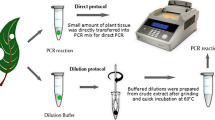Abstract
The polymerase chain reaction (PCR) revolutionized molecular biology to a similar extent as the discovery of plasmids and restriction endonucleases. However, there are some limitations to the use of PCR. Transgenic plants containing potato spindle tuber viroid (PSTVd) cDNA constructs, demonstrated to become de novo methylated upon PSTVd infection, represent a good example to illustrate the advantages of PCR. PSTVd is a 359 nt long autonomously replicating plant pathogenic RNA where all of its enzymatic requirements are entirely provided by the host cell. In addition, viroids that propagate without a DNA intermediate barely tolerate nucleotide substitutions of their RNA genome without losing infectivity. PCR is the method of choice to characterize the sequence context of genome-integrated viroid cDNA or of reverse transcribed PSTVd RNA, and can hardly be replaced by any alternative procedure. Furthermore, the precise examination of DNA methylation patterns (genomic sequencing) is entirely dependent on PCR. In contrast, the use of PCR is critical for the determination of copy number and arrangement of transgene constructs. Here, the advantages and disadvantages of PCR are discussed and protocols for PCR amplification of cDNA, genomic DNA, and bisulfite-treated DNA from transgenic plants are presented.
Similar content being viewed by others
References
Clark, S. J., Harrison, J., Paul, C. L., and Frommer, M. (1994) High sensitivity mapping of methylated cytosines. Nucleic Acids Res. 22, 2990–2997.
De Jong, J., Mertens, M. M. J., and Rademaker, W. (1994) Stable expression of the GUS reporter gene in chrysanthemum depends on binary plasmid T-DNA. Plant Cell Rep. 14, 59–64.
Zhong, H., Bolyard, M. G., Srinivasan, C., and Sticklen, M. B. (1993) Transgenic plants of turfgrass (Agrostis palustris Huds.) from microprojectile bombardment of embryogenic callus. Plant Cell Rep. 13, 1–6.
Grayburn, S. W. and Vick, B. A. (1995) Transformation of sunflower (Helianthus annuus L.) following wounding with glass beads. Plant Cell Rep. 14, 285–289.
Yepes, M. L., Mittak, V., Pang, S.-Z., Gonsalves, C., Slightom, J. L., and Gonsalves, D. (1995) Biolistic transformation of chrysanthemum with the nucleocapsid gene of tomato spotted wilt virus. Plant Cell Rep. 14, 694–698.
Wassenegger, M., Heimes, S., Riedel, L., and Sänger, H. L. (1994) RNA-directed de novo methylation of genomic sequences in plants. Cell 76, 567–576.
Wassenegger, M., Heimes, S., and Sänger, H. L. (1994) An infectious viroid RNA replicon evolved from an in vitro-generated non-infectious viroid deletion mutant via a complementary deletion in vivo. EMBO J. 13, 6172–6177.
Frommer, M., McDonald, L. E., Millar, D. S., et al. (1992) A genomic sequencing protocol that yields a positive display of 5-methylcytosine residues in individual DNA strands. Proc. Natl. Acad. Sci. USA 89, 1827–1831.
Pélissier, T., Thalmeir, S., Kempe, D., Sänger, H. L., and Wassenegger, M. (1999) Heavy de novo methylation at symmetrical and non-symmetrical sites is a hallmark of RNA-directed DNA methylation. Nucleic Acids Res. 27, 1625–1634.
Pélissier, T. and Wassenegger, M. (2000) A DNA target of 30 bp is sufficient for RNA-directed DNA methylation. RNA 6, 55–65.
Wassenegger, M., Spieker, R., Thalmeir, S., Gast, F.-U., Riedel, L., and Sänger, H. L. (1996) A single nucleotide substitution converts potato spindle tuber viroid (PSTVd) from a non-infectious to an infectious RNA for Nicotiana tabacum. Virology 226, 191–197.
Author information
Authors and Affiliations
Rights and permissions
About this article
Cite this article
Wassenegger, M. Advantages and disadvantages of using PCR techniques to characterize transgenic plants. Mol Biotechnol 17, 73–82 (2001). https://doi.org/10.1385/MB:17:1:73
Issue Date:
DOI: https://doi.org/10.1385/MB:17:1:73




